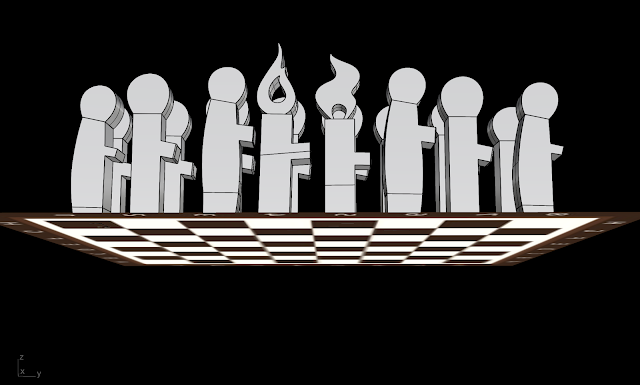A11: 3D-PrintableChess Set
Ash is the ember of the dead fire. - “Article talk”
There is a nation in Africa where babies are born to have 60 years of life.
All the great things in life have to be completed in these 60 years, and the years thereafter will be used to spend the old age. I marvel at the wisdom of this nation's life, also inspired by the life “countdown”.
Ash STATEMENT
On that spring festival, I sat alone in the dark and mused about “death”.
I thought of the little girl selling match who died on the eve of the year due to
freezing, and I burned matches like her. In the fire, I felt the life is like a box of
matches, there are less matches, but at the same time they emit light and heat.
Why does firewood burn? Why do cigarettes exist? What is the value of rust? And then what?
The answers are all in this set of photos.
Firewood is used to boil water and cook rice, to provide for life;
cigarettes comfort the mind, which is the spiritual sustenance;
rust can clear away heat and toxic material, calm heart and liver.
At the same time, they symbolize diverse forms of life, reflect with soil
and gravel of various textures and so on, together create an ode to life.
In the end, ash will return to the dirt as well. However, It ends where it begins from to complete itself.
Ash was one of the works I applied to AUArts.
When the last project was posted on Mosaic, I couldn't help feeling: life is like chess! Meanwhile, I had a strong desire to continue creating with matches.
In class, I asked Bryan if it was too simple. Although I had a language barrier that could not further explain that this piece was more than a chess set, I knew exactly what I was doing. And hope to get some support. Then, a funny thing happened. As I searched for resources for my paper, I suddenly realized a fact that I had overlooked -wasn't my purpose in citing resources just to prove my argument? In the same way, if my design philosophy is similar to some well-known design, then do I need to worry about form? Besides, “It doesn't matter whether a cat is black or white, as long as it catches mice.”
Josef Hartwig, a Munich-born artist, designed a 32-piece chess set (also known as the Hartwig chess) for the Bauhaus between 1923 and 1924 that used minimal lines, circles and squares to reduce the pieces to the basic function of their movement.
By eliminating all the religious and monarchical symbols commonly used in chess, the German designer aims to redesign modern chess.
Richard Meier was an icon to countless architects and non-architects, until he was sidelined by a long history of sexual harassment. The chess set is a souvenir that Meyer designed for wallpaper magazine.
The chess set is very architectural, inspired by the evolution of architectural imagery such as obelisks.
XYZ integrated architecture
They just have architecture in their name, XYZ is essentially an industrial design company. But the chess set they devised was groundbreaking.
Mexican contemporary artist Jorge Yazpik uses the volcanic rock material and the chess made of bronze and stainless steel to carve the material into a labyrinth of negative space, and at the same time combine it into a geometric landscape pattern, which is full of the design language of the building.
Attach mine after the classic👇
Like the designers and the artist mentioned above, I have given new meaning to chess in my own unique way. The six chess pieces, namely images of six matches, represent different stages of life. People grow up in metamorphosis, more mature and more modest!













Comments
Post a Comment